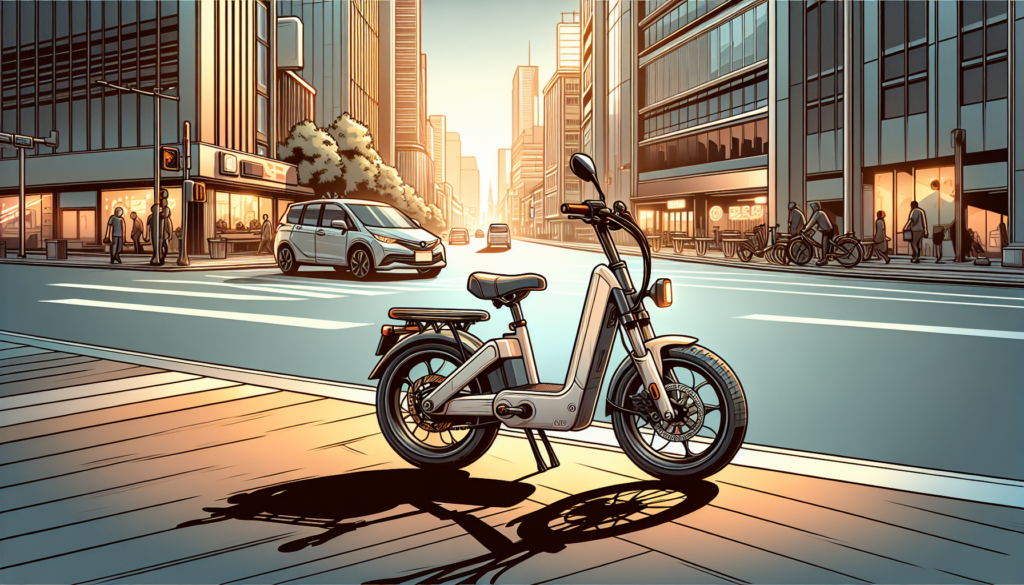
In the ever-evolving world of electric bikes, choosing the right model can be a daunting task, especially with prominent contenders like the Xiaomi Ebike Himo Z20 and the ADO A20 Lite vying for your attention. Both bikes offer unique features that cater to different riding preferences, making them popular choices among commuters and leisure riders alike. The Xiaomi Ebike Himo Z20 boasts a robust dual electrical assist mode, a powerful 36V 10Ah Li-ion battery, and weighs 21.6kg, creating an excellent choice for those looking for versatility in their ride.
However, it’s the ADO A20 Lite from EKO Life MY that stands out with its lightweight design at just 16kg, three electrical assist modes, and a new belt system, offering a fantastic blend of performance and ease of use. In this blog, we’ll dive into the pros and cons of the Xiaomi Ebike when compared to the ADO A20 Lite, helping you make an informed decision for your next biking adventure.
Overview of Xiaomi Ebike Himo Z20 Features
The Xiaomi Ebike Himo Z20 is designed for versatility and performance, featuring dual electrical assist modes: Dynamic Sports Mode and Cool Mode. This means riders can choose between a powerful boost for an exhilarating ride or a more leisurely pace. Equipped with a 36V 10Ah Li-ion battery, the Himo Z20 can achieve a range of approximately 60km, making it suitable for both short commutes and longer excursions. Weighing in at 21.6kg, it has a maximum load capacity of 100kg, allowing it to handle diverse riding conditions with ease. The chain system and mechanical disc brakes further enhance durability and reliability, providing a stable ride over varying terrains.
With a price tag of RM 3,099, it positions itself as a pragmatic choice for budget-conscious riders seeking quality and performance in an electric bike. In comparison, the ADO A20 Lite stands out with its lighter weight of just 16kg and features three electrical assist modes, providing more customizable riding experiences. Like the Himo Z20, it also offers a 36V 9.6Ah Li-ion battery with a 60km range and can support a maximum load of 100kg, making it equally competitive in range and capacity.
However, the A20 Lite boasts a belt system, which requires less maintenance compared to a chain system. At RM 3,699, it is priced higher, but the added features and lower weight could justify the cost for those aiming for an easily manageable e-bike without compromising on performance.
Overview of ADO A20 Lite Features
The ADO A20 Lite stands out in the ebike market, offering three distinct electrical assist modes tailored to various riding preferences. This feature allows riders to switch between modes for enhanced efficiency, making it suitable for both leisurely rides and more demanding conditions. Powered by a 36V 9.6Ah Li-ion battery, the ADO A20 Lite boasts an impressive range of approximately 60 km, allowing for longer journeys without the need for frequent recharging. With a lightweight design of just 16 kg, this ebike is particularly appealing to those looking for portability without sacrificing performance.
It also supports a maximum load capacity of 100 kg, making it an excellent choice for commuting or errands, providing impressive versatility to its users. The belt system not only delivers smooth operation but also requires less maintenance compared to chain systems found in other options, such as the Xiaomi Ebike. In terms of braking, the ADO A20 Lite is equipped with mechanical disc brakes, providing reliable stopping power.
Moreover, at a price point of RM 3,699, this ebike offers a competitive alternative to the Xiaomi Ebike Himo Z20, which retails for RM 3,099. While the Xiaomi Ebike features a dual electrical assist mode, the advanced versatility and lightweight design of the ADO A20 Lite set it apart. Riders can enjoy the freedom of customization and the convenience that comes with the ADO A20 Lite, making it an appealing option for urban commuters and adventure seekers alike.
Performance Analysis: Battery and Range Comparison
When comparing the Xiaomi Ebike Himo Z20 and the ADO A20 Lite, both models demonstrate impressive performance in terms of battery and range. The Xiaomi Ebike features a powerful 36V 10Ah Li-ion battery that offers a range of approximately 60km, providing ample energy for longer rides or commutes. Additionally, the Himo Z20 supports dual electrical assist modes, allowing riders to choose between a more dynamic sports mode or a cooler driving experience. However, with its heavier weight of 21.6kg, it may present challenges for those needing to carry it or navigate through tougher terrains.
On the other hand, the ADO A20 Lite stands out with its lighter weight of just 16kg, making it more manageable for daily use and transport. Equipped with a slightly smaller 36V 9.6Ah Li-ion battery, it offers the same impressive range of approximately 60km as the Xiaomi Ebike. The ADO A20 Lite‘s three electrical assist modes enhance versatility, allowing users to adapt their riding style based on conditions and energy conservation needs. This combination of efficiency and lightweight structure may appeal to urban commuters, highlighting the ADO A20 Lite as a commendable choice in this performance analysis.
Weight and Portability: Which Ebike is More Convenient?

When considering weight and portability, the Xiaomi Ebike Himo Z20 weighs 21.6kg, making it a bit heavier compared to the ADO A20 Lite, which is only 16kg. This difference in weight can significantly impact the convenience of maneuvering the bike in everyday situations. For instance, the lighter weight of the ADO A20 Lite allows for easier handling and transportation, whether you’re carrying it up a flight of stairs or loading it into a car. Additionally, its lighter frame can make a notable difference when navigating through congested urban areas, offering riders greater agility and control.
The ADO A20 Lite‘s belt system adds to its appeal in terms of maintenance and ride smoothness, enhancing the overall portable experience. A lighter eBike not only means improved convenience but also reduced fatigue during rides, especially for those who may need to carry their bike onto public transport or maneuver it through tight spaces. With both bikes sharing a similar range of approximately 60km, the choice between the two often comes down to how important portability and ease of transport are for the rider’s lifestyle. Thus, with its excellent balance of weight and features, the ADO A20 Lite stands out as the more convenient option in terms of weight and portability.
Electrical Assist Modes: A Look at Xiaomi and ADO
When it comes to electrical assist modes, the Xiaomi Ebike Himo Z20 offers a choice between two distinct settings: Dynamic Sports Mode for more thrilling rides, and Cool Mode for a more relaxed experience. This feature allows riders to tailor their biking journey based on their preferences and the terrain. With its dual assist mode powered by a robust 36V 10Ah Li-ion battery, the Himo Z20 ensures a range of approximately 60km, making it a suitable option for both commuting and leisurely strolls. However, its slightly heavier weight of 21.6kg can be a downside for some users, especially those seeking a lighter bike for easy handling and portability.
On the other hand, the ADO A20 Lite presents riders with three electrical assist modes, which enhance control and versatility, catering to different riding styles and conditions. This model is equipped with a 36V 9.6Ah Li-ion battery, yielding a comparable range of about 60km, yet it stands out due to its lightweight design at just 16kg. This feature significantly enhances maneuverability and ease of transport without compromising load capacity. With mechanical disc brakes and a belt system, the ADO A20 Lite provides a seamless riding experience, all at a price of RM 3,699. These attributes make the ADO A20 Lite an attractive alternative for those valuing lightweight efficiency alongside reliable performance.
Load Capacity: Similarities and Differences
The ADO A20 Lite‘s lighter frame is particularly advantageous for those seeking ease of maneuverability and transport, especially for urban riders who frequently navigate crowded spaces. Additionally, the ADO model features a belt system, which can contribute to smoother and quieter rides compared to the chain system of the Xiaomi Ebike. This is an essential point for riders considering regular trips in public areas or geographies where noise levels matter. Ultimately, while both models support a similar load capacity, the ADO A20 Lite‘s lighter weight and quieter operation may offer enhanced convenience for everyday users.
Design and Build Quality: Chain vs Belt System
When comparing the Xiaomi Ebike Himo Z20 and the ADO A20 Lite, one of the notable differences lies in their design and build quality, particularly concerning the chain and belt systems. The Xiaomi Ebike features a traditional chain system which is robust and widely recognized for its durability. This design, however, may require more maintenance over time due to the potential for rust and wear, especially if exposed to harsh weather conditions. Moreover, the weight of the Xiaomi Ebike Himo Z20 at 21.6 kg contributes to its sturdiness but can be perceived as a drawback for users seeking lightweight options for easier transportation.
On the other hand, the ADO A20 Lite employs a belt system known for its low maintenance and quiet operation. Weighing just 16 kg, it offers excellent portability without compromising strength or performance, making it ideal for urban commuting. Additionally, the belt system reduces the need for lubricant and is less prone to wear and tear compared to the chains. This design quality makes the ADO A20 Lite not only efficient but also appealing for those looking for a hassle-free riding experience. Ultimately, the choice between these two models will hinge on the individual rider’s priorities, such as maintenance preferences and weight considerations.
Price Comparison: Value for Money for Each Ebike
When considering the price of electric bikes, the Xiaomi Ebike Himo Z20 comes in at a competitive RM 3,099. With features like a dual electrical assist mode, a robust 36V 10Ah Li-ion battery that promises a range of about 60km, and a weight of 21.6kg, it offers substantial value for those looking for versatility. The mechanical disc brakes and chain system further add to its reliability and ease of use for most riders. However, while it delivers solid performance at an attractive price point, its slightly heavier build might deter customers focused on portability.
In contrast, the ADO A20 Lite has a higher price tag of RM 3,699, which some may question. However, this bike compensates for its elevated cost through a sleeker design weighing only 16kg and featuring three electrical assist modes, making it an appealing choice for urban riders who prioritize lightness and ease of handling. With a similar range of approximately 60km from a 36V 9.6Ah Li-ion battery and an intuitive belt system for a quieter ride, the ADO A20 Lite may represent better value for those who need a lightweight, efficient commuting solution. Ultimately, the choice between the two will depend on the individual rider’s preferences and priorities.
Final Thoughts: Choosing Between Xiaomi Ebike and ADO A20 Lite

In conclusion, both the Xiaomi Ebike Himo Z20 and the ADO A20 Lite offer unique advantages tailored to different riders. The Xiaomi Ebike model boasts a powerful dual electrical assist mode and a robust chain system, making it an excellent choice for those seeking dynamic performance on varied terrains. Its slightly higher weight and lower price point may appeal to budget-conscious consumers who still crave quality and efficiency. However, it’s important to note that while the Xiaomi Ebike is commendable, the ADO A20 Lite shines in its own right, especially with its lightweight design and three electrical assist modes that cater effectively to urban commuting.
Furthermore, the ADO A20 Lite‘s belt system is a significant advantage for those prioritizing lower maintenance and a smoother ride over longer distances. Although it comes with a higher price tag, the enhanced features may justify the investment for potential buyers looking for long-term comfort and reliability. Ultimately, the choice between the Xiaomi Ebike and ADO A20 Lite will depend on individual preferences and riding needs, but it’s clear that both models stand out in their categories, providing exceptional value to their users.

I’m so disappointed that the blog summary is empty. I was expecting some insightful information but got nothing. What a waste of time.
Hello Eesa, sorry to hear that you found our blog summary lacking. We appreciate your feedback and would like to make things right. Our blog should provide valuable insights to our readers. Could you please contact us via phone at +60 3-7890 3042 or email at [email protected] so we can discuss further and provide a better experience for you? We value your opinion and want to ensure our blog meets your expectations.
I think this is a great opportunity for the blog to create a new article. Maybe they got stuck with a bad idea. Hopefully, they’ll come back with something better next time.
Thank you for sharing your thoughts, Nazlie. We appreciate your feedback and will take it into consideration. We value your opinion and would like to encourage you to reach out to us if you have any suggestions or ideas for new articles. You can contact us at [email protected] or +60 3-7890 3042.
Can’t believe I wasted my time on this empty blog! Improve your content strategies! I’m not coming back here. Not impressed!
We apologize for your disappointment with our blog content. At Eko Life Malaysia, we strive to provide valuable information and insights to our customers. We’d like to invite you to contact us directly via [email protected] or +60 3-7890 3042 to discuss your concerns and gather feedback on how we can improve our content strategies. Your input would be greatly appreciated.